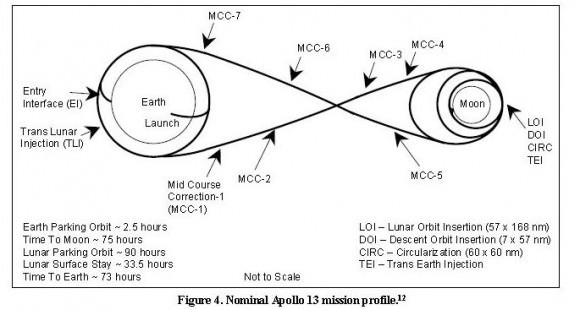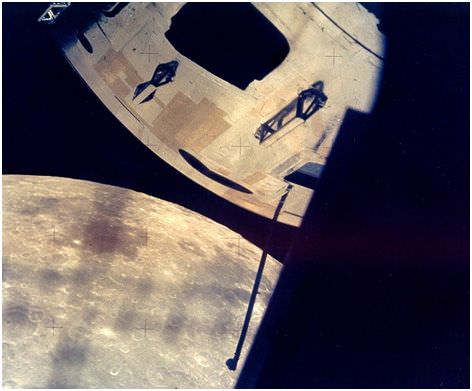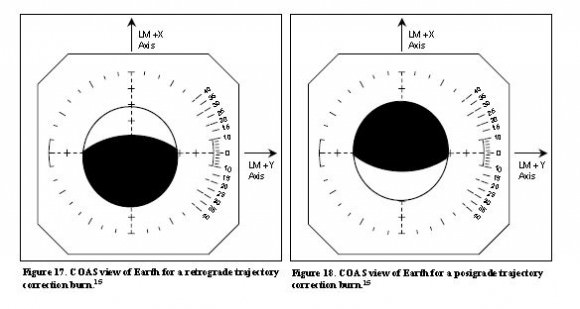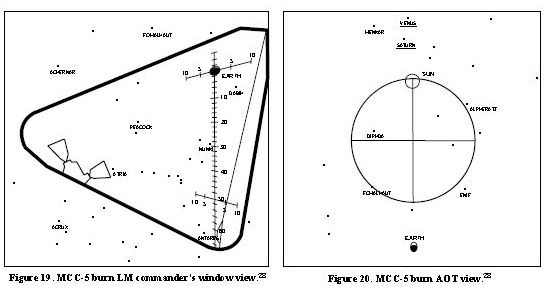[/caption]
Note: To celebrate the 40th anniversary of the Apollo 13 mission, for 13 days, Universe Today will feature “13 Things That Saved Apollo 13,” discussing different turning points of the mission with NASA engineer Jerry Woodfill.
The rupture and explosion of Apollo 13’s oxygen tank crippled the spacecraft, endangering the lives of the crew and making a Moon landing not an option. But more problems arose as the perilous flight progressed. Keeping the spacecraft on the right trajectory was a huge challenge for Mission Control, and especially for the crew. Normally, the ship’s computers allowed for much of the navigation, but due to the loss of the Service Module as an electrical power source, even backup navigation and targeting functions were unavailable. The Lander’s limited battery power required the shutting down of its guidance computer. The astronauts also needed to use an on-board sextant to confirm their location by sighting-in the stars, similar to how ancient sailors navigated. “There are thirty-seven stars – and one is the sun,” said Apollo engineer Jerry Woodfill, “that provided an accurate way of aligning the spacecraft’s computer platform to allow the astronauts to steer their way through the heavens.”
But the explosion of the tank had enshrouded the Apollo 13 spacecraft with debris. Commander Jim Lovell and his crew couldn’t discern the stars from the particles that glimmered in the sunlight. “The situation was, without the ability to see the stars, you couldn’t navigate,” Woodfill said.
But NASA had a backup navigation plan, thanks to an insightful NASA contractor employee. This novel way of navigating had only been tried once before in space. And coincidentally, the astronaut who used it was Jim Lovell, during his previous flight — Apollo 8 — which orbited the Moon in December of 1968.
An employee of TRW – which was the contractor for many of the navigational systems and procedures for NASA — thought of an unusual backup navigation plan one day. “This fellow is a friend and neighbor of mine,” said Woodfill, “and by his account of the story to me, he said that a thought came to him one day about Apollo astronauts using stars to navigate. What if the stars couldn’t be seen? Now, that was highly unlikely, as there are no clouds, fog, or smoke to conceal stars from viewing by astronauts. But, nevertheless, the thought simply wouldn’t cease. Soon a follow-up idea came to mind. Why not use the Earth’s terminator?”

The terminator is the line which delineates between night and day on Earth; where the Sun is shining and where it is dark.
Woodfill’s friend figured out the geometry and wrote a computer program to validate the idea. He submitted the proposal to the navigation board, which approved the technique so that it was entered into the computers in the Mission Control Center.
Through unusual, and what could be called happenstance circumstances, Lovell experimented with the backup plan during Apollo 8.
Lovell served as navigator for the first manned mission to orbit the Moon. He made a star sighting in preparation for the return to Earth, and entered the coordinates into the Apollo spacecraft’s primitive computer using the “DSKY” (display and keyboard). Instead of pressing the ENTR (enter) key, he inadvertently pressed the adjacent CLR (clear) key erasing the entire navigational alignment.
“Lovell consulted with Mission Control whether to repeat the sextant star sighting,” Woodfill said, “and someone realized this would be an opportunity to test the backup ‘seat of the pants’ means of navigating using the Earth’s terminator. And it worked! But then everyone forgot about it, until…guess when?”

Initially, the Apollo 13 crew was able to use the Sun as a “marker” to help in guiding the spacecraft to confirm they were on the right path, and were able to fire the LM engines for course corrections using the transferred guidance platform from the Command Module.
But as Apollo 13 headed back to Earth, the Reentry (RETRO) and Guidance, Navigation and Control (GNC) officers looking at the trajectory analysis noticed the spacecraft was coming in too “shallow,” that is, Apollo 13 was headed to skip off the atmosphere and out into space forever. Something seemed to be “blowing” the spacecraft off course. Later, it was discovered that cooling vapor from the lander was responsible. Since no lander had been present for previous missions on a return trip from the Moon, such a mysterious “wind” had never been encountered prior to Earth re-entry.
Another burn was needed, but no help from the guidance system would be available, as powering the lander’s guidance system, its gyros, the computer, etc. would use too much electrical power.
Here’s where the backup navigation approach that Lovell experimented with on Apollo 8 came to the rescue.
“If a ‘dead-reckoning’ approach could be used, no electricity would be needed,” said Woodfill. “Simply point the vehicle correctly, start the engine and stop it based on Mission Control’s prescribed time for its operation.” Lovell eyed up the Earth’s terminator line and controlled the “yaw” of the spacecraft, Haise controlled the “pitch” and Swigert timed it with his accurate Omega Speedmaster watch.

The Navigation report for Apollo 13 describes it this way:
“The cusps of the Earth terminator were placed on the Y axis of the COAS. The illuminated part of the Earth was placed at the top of the reticle. Pitch attitude was achieved by placing the Sun in the upper portion of the AOT (see below). This procedure aimed the LM +Z axis at the Earth and aligned the LM +X axis retrograde along the local horizontal. An AGS body axis alignment was performed, followed by transitioning the AGS to the automatic attitude hold mode. A maneuver to burn attitude was performed, followed by another body axis alignment.”

Woodfill said he enjoyed Hollywood’s re-enactment of the procedure in the “Apollo 13” movie. Though the spacecraft gyrations about the heavens are wholly exaggerated, the scene where Tom Hanks, Bill Paxton, and Kevin Bacon set-up and execute the terminator burn is generally accurate.
Suffice to say, the procedure worked for Hollywood dramatics, but more importantly, it worked to save the lives of Lovell, Haise and Swigert.
Tomorrow, Part 6: Fire
Other articles from the “13 Things That Saved Apollo 13” series:
Part 2: The Hatch That Wouldn’t Close
Part 3: Charlie Duke’s Measles
Part 4: Using the LM for Propulsion
Part 5: Unexplained Shutdown of the Saturn V Center Engine
Part 6: Navigating by Earth’s Terminator
Part 8: The Command Module Wasn’t Severed
Part 12: Lunar Orbit Rendezvous
Part 13: The Mission Operations Team
Also:
Your Questions about Apollo 13 Answered by Jerry Woodfill (Part 1)
More Reader Questions about Apollo 13 Answered by Jerry Woodfill (part 2)
Final Round of Apollo 13 Questions Answered by Jerry Woodfill (part 3)
Never Before Published Images of Apollo 13’s Recovery
Listen to an interview of Jerry Woodfill on the 365 Days of Astronomy podcast.


Another excellent Nancy, thanks for that.
🙂
Wow!
I hope you will make this fascinating series available in the end as a single downloadable document!
It is interesting that these calculations were done on the ground using tools available at the time. The delta-vee needed was computed with respect to this coordinate system on the spacecraft, oriented with the Earth’s terminator using IBM mainframes and probably a fair number of slide rules.
LC
A schematic figure of the unhelpful Apollo space sextant is published under paragraph 4.1.4 on pg. 22 at
http://trs-new.jpl.nasa.gov/dspace/bitstream/2014/29907/1/95-0659.pdf
And this picture shows its use by James Lovell during the Apollo 8 flight:
http://upload.wikimedia.org/wikipedia/de/5/53/Apollonav.jpg